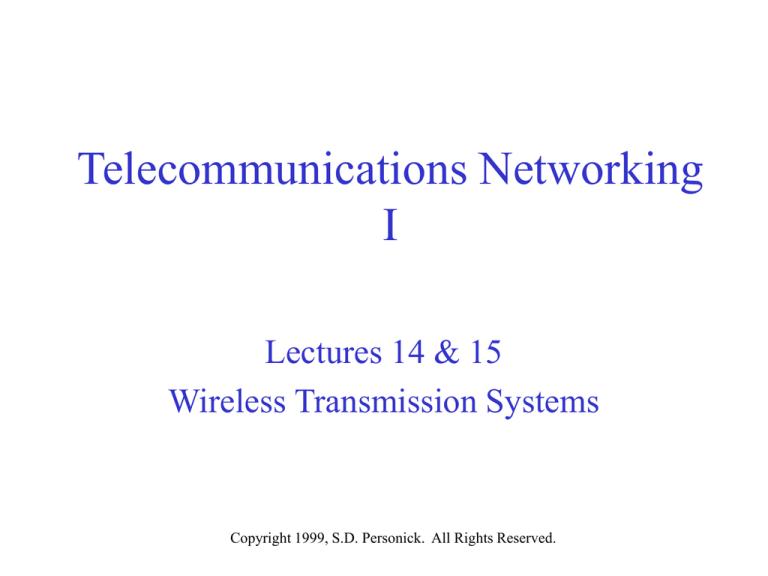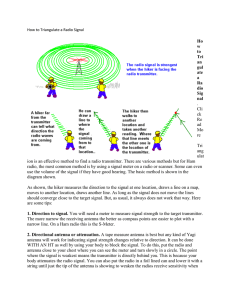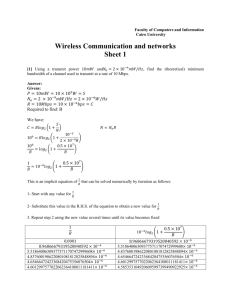
Telecommunications Networking
I
Lectures 14 & 15
Wireless Transmission Systems
Copyright 1999, S.D. Personick. All Rights Reserved.
Wireless Point-to-Point Link
Antenna
Feed Line (e.g.,
coaxial cable)
Radio
Transmitter
Radio
Receiver
Copyright 1999, S.D. Personick. All Rights Reserved.
The Electromagnetic Spectrum
•
•
•
•
•
•
•
•
30-300Hz: SLF
3GHz-30GHz: SHF (DBS)
300Hz - 3kHz ULF
30GHz-300GHz: EHF
3kHz - 30kHz: VLF 300,000GHz: 1um light
30kHz-300kHz: LF
300kHz-3MHz: MF (AM Radio)
3MHz-30MHz: HF (Short Wave Radio)
30MHz-300MHz: VHF (FM, TV)
300MHz-3GHz: UHF (TV, Digital Cordless, …)
Copyright 1999, S.D. Personick. All Rights Reserved.
Wireless Transmitter
Antenna
Information
Modulator
Mixer
IF Oscillator
RF Oscillator
RF
Amp
Copyright 1999, S.D. Personick. All Rights Reserved.
Transmitter Subsystems
• 1 milliwatt -100 milliwatts: low r.f. exposure with
hand held appliances, low battery drain (some
hand held appliances radiate ~5 watts…but I
wouldn’t hold one of these near my head!)
• 10 watts - 100 watts: okay for consumer and small
business applications, with 115 volt or 12 volt
automobile power. Stay 10-30 feet from the
antenna.
• 5000 watts-50,000 watts : broadcast applications
Copyright 1999, S.D. Personick. All Rights Reserved.
Transmitter Subsystems
R.F. Power = (V**2)/Z
Antenna
V~ 1 volt
Z~50 ohms
FET
Coax
R.F. Amplifier
R.F. Power (launched into the
coaxial cable) = 1/50 Watt =
20 mW
R.F. Power radiated = ?
Copyright 1999, S.D. Personick. All Rights Reserved.
The Antenna
Reflected Power
Radiated Power
Forward Power
Copyright 1999, S.D. Personick. All Rights Reserved.
The Antenna
• If the antenna is much smaller in length than the
wavelength of the radiation (c/f), then the antenna
will be a very inefficient radiator (most of the
forward power is reflected)
• If the antenna is 1/4 wavelength or larger in size, it
can be an efficient radiator
• If the antenna is significantly larger in size than 1
wavelength, it can be an efficient and directional
radiator
Copyright 1999, S.D. Personick. All Rights Reserved.
A Directional Radiator
Reverse: fields cancel
1/4 wavelength
spacing between two
dipoles. 3/4
wavelength delay in
crossover cable
Forward: fields add
It’s actually not quite that simple: dipole interactions
Copyright 1999, S.D. Personick. All Rights Reserved.
The Parabolic Dish Antenna
Divergence angle
~Lambda/D
Copyright 1999, S.D. Personick. All Rights Reserved.
Wireless Receiver
Antenna
Information
Demodulator
Mixer
IF Oscillator
RF Oscillator
RF
Amp
Copyright 1999, S.D. Personick. All Rights Reserved.
The Receiver Subsystem
Signal + Background Noise + Interference
Cable attenuation + thermal noise
+ Amplifier noise
Low Noise Amplifier
Copyright 1999, S.D. Personick. All Rights Reserved.
Sources of Thermal Noise
Sun
Background (27K)
Signal
Field of View
Mirror
Hot object (333K)
Copyright 1999, S.D. Personick. All Rights Reserved.
The Receiver Subsystem
Example:
Equivalent background temperature: T = 100K (Kelvins)
Equivalent background noise = kTB (watts)
Coupling loss of antenna into cable ~ 0dB
Cable loss = 3 dB
Cable temperature = 293K
Preamplifier Noise Temperature = 30K
Equivalent amplifier total input noise = ???
Copyright 1999, S.D. Personick. All Rights Reserved.
The Receiver Subsystem
Example (continued):
Equivalent input noise = kB [100/2 + 293/2 + 30]=226.5kB
I.e., half of the background noise + half of the cable noise +
the preamplifier noise
Copyright 1999, S.D. Personick. All Rights Reserved.
The End-To-End System
Example (continued from prior example):
Assume that the transmitter power amplifier produces 20
milliwatts. The coupling loss from the transmitter into its
coaxial antenna feed cable is 0 dB. The transmitter antenna
feed cable has 1.5 dB of loss. The antenna radiates 90% of the
power that arrives from the transmitter antenna feed cable, and
reflects the rest back into the cable.
How much power is radiated? Assume that the bandwidth,
B = 6 MHz. How much total propagation loss can we allow if
the required signal-to-noise ratio is 40 dB?
Copyright 1999, S.D. Personick. All Rights Reserved.
The End-to-End System
Example: (continued)
The preamplifier produces 20 mW = +13 dBm
The loss of the cable, plus the impact of a 10%
reflection (90% radiation) is:
1.5 dB (cable loss) - 10 log (0.9) = 1.95 dB
The total radiated power = +11.05 dBm = 12.7 mW
The required power at the preamplifier input = 226.5 x k
x 6 x 10**6 x 10**4 (watts)... I.e., 40 dB larger than the
noise
Copyright 1999, S.D. Personick. All Rights Reserved.
The End-to-End System
• The radiated power = 12.7 mW
• The required power at the receiver
preamplifier input = 1.85 x 10**-7 mW
• The required power at the receiver antenna is
2 x 1.85 x 10**-7 mW = 3.7 x 10**-7 mW
• The allowed propagation loss is the ratio of
these ~3.4 x 10**7 ~ 75.3 dB
Copyright 1999, S.D. Personick. All Rights Reserved.
Calculating the Propagation Loss
Antenna equivalent
area = A
Area of surface
= 4 r**2
Copyright 1999, S.D. Personick. All Rights Reserved.
Calculating the Propagation Loss
Suppose the frequency is 100 MHz, and the
wavelength = 3 meters. Assume that the
equivalent area of the antenna is 2.25 square
meters.
If the allowable loss is 75.3 dB, then the distance
from the transmitter to the receiver, r , can be
derived from:
2.25/[4 r**2) > 1/[3.4 x 10**7];
r < 2.5 km (Line-Of-Sight)
Copyright 1999, S.D. Personick. All Rights Reserved.
Why Do Broadcast Transmitters
Have Such High Power?
In the previous example, we could cover 2.5 km
with 20 mW. If we want to cover a 100 km radius,
we would need 40**2 or 1600 times the power.
That would correspond to 32 watts << 10 kW
But, what about: high antenna-feeder-cable losses,
splitters, noisy preamplifiers, inadequate antennas
(low effective area, and poor matching to the
feeder cable), attenuation through buildings, and
fading
Copyright 1999, S.D. Personick. All Rights Reserved.







